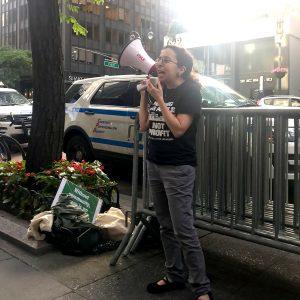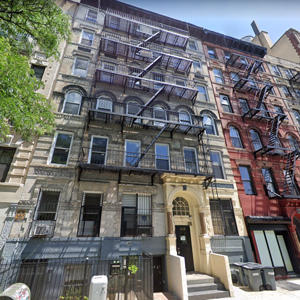Nearly half of Raphael Toledano’s East Village portfolio is sitting vacant — mired in bankruptcy proceedings with lender Madison Realty Capital.
Andrea Shapiro, program manager of tenants’ rights group Met Council, estimated that half of the 279 units have been “warehoused” since 2016. The portfolio includes 226 rent-stabilized apartments, according to tax filings.

Met Council’s Andrea Shapiro
A Madison Realty Capital spokesperson blamed Toledano, saying, “The owner of the properties demolished the vacant units a few years ago and therefore the vacant units are not habitable at this time.” She noted that Madison still does not own them. Toledano did not return a request for comment, and his attorney declined to comment.
A Madison subsidiary took over management of the 15-building portfolio in 2017 after Toleando filed for bankruptcy. Toledano had received $124 million in cash and lines of credit from Madison to finance his $97 million purchase of the buildings, but then was accused of harassing tenants in a bid to vacate and deregulate units in them.
Read more


But thanks to drawn-out court proceedings, a bankruptcy plan has yet to be executed. Toledano’s role in the management of the portfolio was severely limited when a federal judge assigned the rents and management duties to Madison subsidiary Silverstone Property Group. The proceedings have been subject to numerous extensions, and tenants who remain have been left in the dark.
“I don’t know why they waited. Maybe [Madison] didn’t see it dragging out this long,” longtime Toledano building resident Jim Markowich said of the bankruptcy proceedings. “In the meantime, it’s really created a bizarre and ghostly situation to live in.”
At the time that Madison took over as property manager of the portfolio, then-Attorney General Eric Schneiderman called Madison’s strategy a “loan to own” play that demanded Toledano use aggressive tactics to try to provide impossible returns for their investors — and allowed Madison to take control of the properties when they defaulted.

325 East 12th Street (Credit: Google Maps)
Kathy Wakeham, who has lived at 325 East 12th Street for 40 years, estimated that half of the building’s 37 apartments are empty.
“There’s no reason to keep them vacant,” Wakeham said, although she speculated that Madison may be seeking to combine adjacent units to set a first rent — one of the few ways to potentially increase rents under the state’s new rent law. But if half the units were vacant, there would already be plenty of opportunities to combine units — and that has not happened.
Last year’s passage of rent reforms severely limited the amount of money landlords could recover from tenants for renovations, and eliminated nearly all pathways to converting rent-regulated apartments to market-rate. That erased the profit incentive for owners of rent-regulated buildings to invest in expensive renovations, but supporters of the new law hoped that landlords would simply do basic upkeep and keep apartments affordable — not warehouse them.
However, in this case the culprit appears to be the bureaucracy of bankruptcy proceedings, not the new rent law. It was the prior rent law that incentivized landlords to push out tenants, in some cases by doing construction work in and around their apartments.
Last June, Toledano reached a $3 million settlement with New York’s attorney general following accusations that he violated the rent-stabilization law and harassed tenants. RuthAnne Visnauskas, the commissioner of the state’s Division of Homes and Community Renewal, said tenants were “terrorized by Toledano’s pervasive threats, fraud and scheming.”
Madison, one of New York City’s most active private lenders, topped off its fourth debt fund in April. The roughly $1.1 billion raise came from investors in the U.S., Europe, the Middle East and Asia, including public and corporate pension funds, foundations and endowments.
In October, according to board meeting minutes, the Texas Municipal Retirement system committed $100 million to the firm’s real estate debt fund, adding to previous investments with the New York-based lender. Madison Realty Capital received $50 million in commitments from the New York State Teachers’ Retirement System in 2015.
Write to Georgia Kromrei at gk@therealdeal.com
